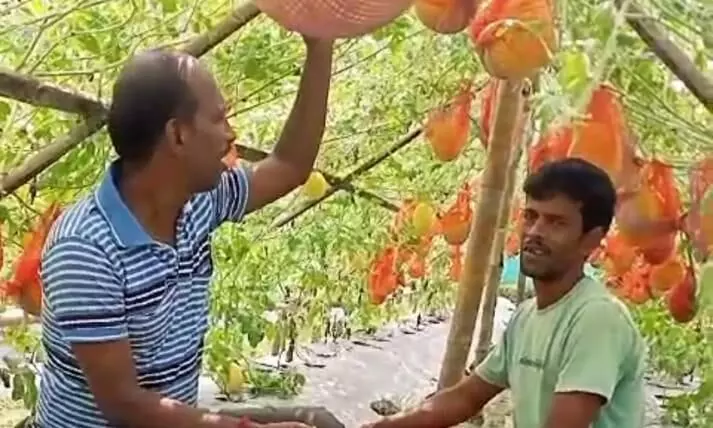
AT Photo
Agartala, Nov 26: Golaghati, a tranquil village in Tripura's Sepahijala district, is achieving agricultural success through innovative farming practices. The cultivation of "Yellow Watermelons," introduced on an experimental basis, proved to be a triumph for the mixedly populated village. Agriculture Sector Officer Bishalgarh Prabir Datta mentioned that 7 kanis of land were dedicated to this unique crop, resulting in a bountiful harvest and substantial profits for participating farmers.
“This is an exclusive crop introduced here on an experimental basis. The experiment, however, turned out to be successful, as the farmers fetched a good harvest at the end of the season," said Agriculture Sector officer Bishalgarh Prabir Datta.
Datta also said, “This year, a total of 7 Kanis of land had been brought under Yellow Watermelon cultivation. The harvest is pretty good and the farmers who got involved in this new venture earned a good profit.”
Farmers like Animesh Sarkar, Tanmay Sarkar, Subhankar Deb and Ramu Roy took the pioneering attempt with the technical support from officials of the agriculture department.
“The farmers have earned a total profit of rupees one lakh per kani of land after selling out their harvest. Taking cue from their success, farmers from all over the district have now decided to start farming this new crop in the next season," Datta told The Assam Tribune.
On being contacted, farmer Animesh Sarkar said, “Watermelon is already considered to be one of the most profit making crops. But, this special variant of the fruit has higher demand in the local market because of its delicate taste and attractive look. The Horticulture department has played an instrumental role in making this experiment a success."
According to the farmers, this fruit has been sold at a price ranging from Rs 40 to 70 in wholesale, while Rs 70 to 80 is the retail price in the local market.
“For one kani of land, a total of Rs 35 to 40 thousand was spent for sowing, tilting of land, labour charge and sprinkling of manures, fertilizers and pesticides. On the other hand, the harvest for one Kani was sold at Rs 1,35,000 to 1,45,000”, said Sarkar.
This new fruit had also drawn a huge footfall of agriculture enthusiasts into the fields.
